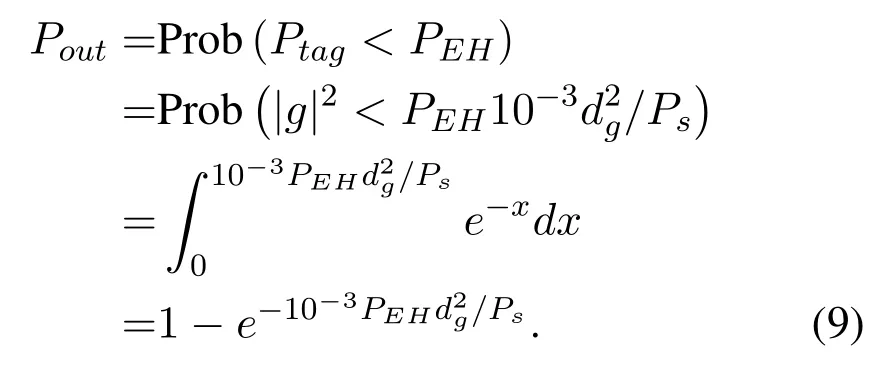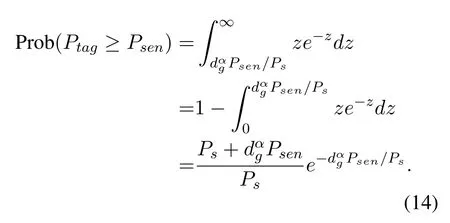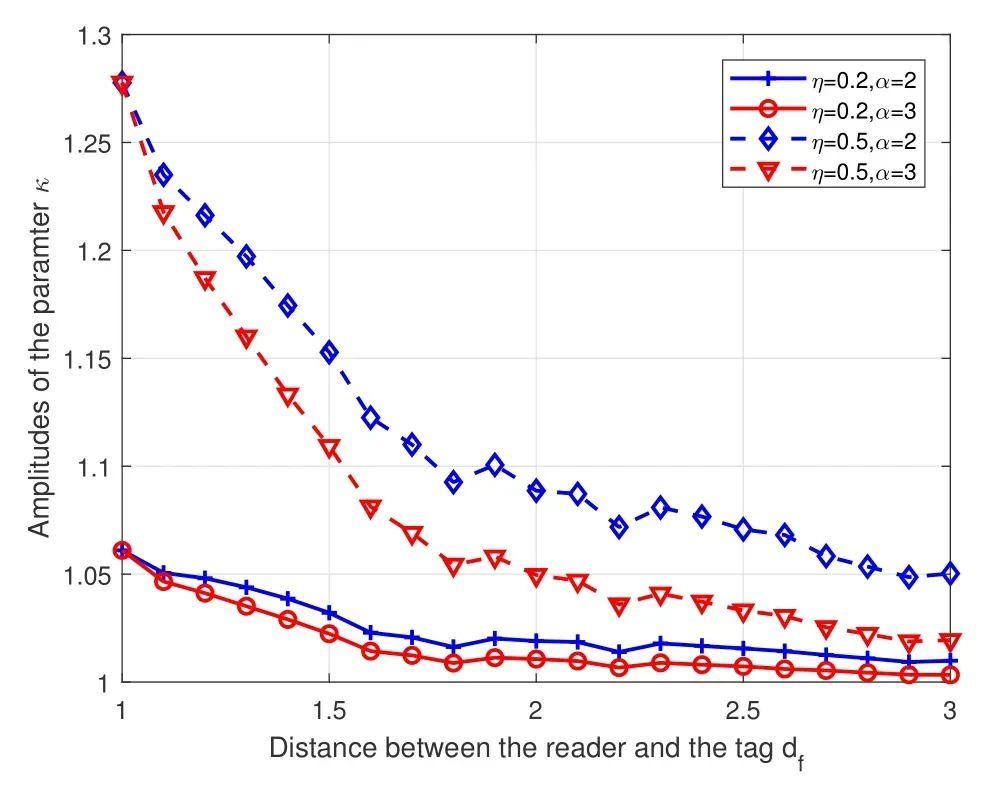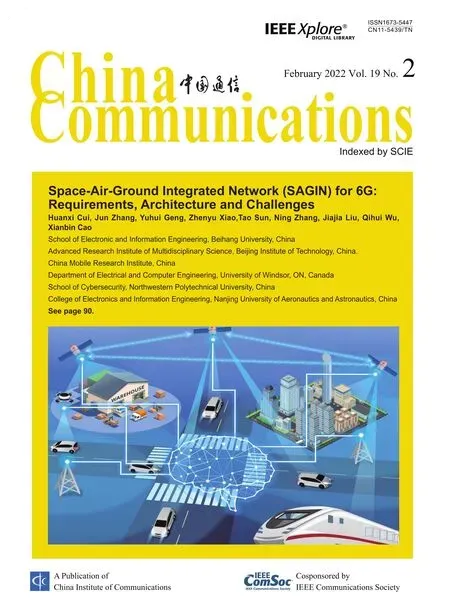Sensitivity and Distance Based Performance Analysis for Batteryless Tags with Transmit Beamforming and Ambient Backscattering
Minzheng Jia,Chaochao Yao,Wei Liu,Ruyi Ye,Tutun Juhana,Bo Ai
1 Department of Information Engineering,Beijing Polytechnic College,Beijing 100042,China
2 School of Computer and Information Technology,Beijing Jiaotong University,Beijing 100044,China
3 School of Communication and Information Engineering,Xi’an University of Posts and Telecommunications,Xi’an 710121,China
4 Chinese National Institute of Standalization,Beijing 100088,China.
5 School of Electrical Engineering and Informatics,Institut Teknologi Bandung,Indonesia
6 State Key Laboratory of Rail Traffic Control and Safety,Beijing Jiaotong University,Beijing 100044,China
Abstract: Ambient backscatter is a new green technology for Internet of Things (IoT) that utilizes surrounding wireless signals to enable batteryless devices to communicate with other devices.The battery-free devices first harvest energy from ambient wireless signals and then backscatter the signals for communications.Clearly, sensitivity and distance are two important parameters for system performance.However,most existing studies on ambient backscatter communication systems do not consider the impact of the sensitivity of the energy-harvesting nodes and the distances between these devices.In this paper, we first provide a literature review for ambient communication technology and then take sensitivity and distance as two key parameters and investigate the sensitivity and distance based performance for ambient backscatter communication systems.Specifically, we establish the mathematical model based on distances between transceivers and backscattering nodes, extract a parameter that can differentiate the direct path and the backscattering path, evaluate the effects of transmit beamforming, design an energy detector for the reader, and analyze the outage probability of energy harvesting at the tag and the bit error rate(BER)at the reader.Simulations are then provided to corroborate the proposed studies.
Keywords: ambient backscatter; battery-free tag; Internet of Things (IoT); outage probability; performance analysis;sensitivity;transmission distance
I.INTRODUCTION
In recent years, Internet of Things (IoT) has gained considerable interest in academical and industrial communities.Getting everything connected, i.e., Internet of Everything, is one ambitious goal of the emerging fifth generation(5G)of mobile communication networks[1][2].Furthermore,future sixth generation(6G)aims at smartly connecting everything[3].
Ambient backscatter, a green communication technology originated from [4] and first proposed in [5]for IoT [6], can enable battery-free tags or sensors to communicate with other devices through remodulating and backscattering ambient RF signals,such as existing WiFi,television(TV),and cellular signals.
Due to its ability to free sensors or tags from battery and low cost with little requirement on RF components,ambient backscatter has attracted wide interest among academic circles [7] - [8].Reference [7]suggests a differential encoding scheme that can eliminate the necessity of channel estimation and can decode the tag information via signal power difference.Furthermore, reference [9] proposes a non-coherent signal detector for ambient backscatter communication networks without channel information (CSI) and also training symbols.Additionally, a semi-coherent detector is provided in [10], where particularly selected channel-related parameters are estimated from unknown data symbols and a few pilot symbols.
Reference [11] exploits multiple-antenna readers,investigates the signal detection problem and analyzes the corresponding BER performance so as to address the channel fading problem and to enlarge the communication range.
Backscatter technology is also introduced to the wireless systems on high speed railways[2][12][13].It is also worth noting that large intelligent surface(LIS), also referred to as reconfigurable intelligent surface (RIS) [14], is a device that integrates many backscatter units [15].Clearly, there arise a series of open problems for the new backscatter technologies,including transceiver design, resource allocation and optimization [16], coding scheme [17]] and security[18].and artificial intelligence(AI)related topics[19].
It is worth noting that recently underwater communication networks also apply backscatter technology due to its low cost and convenience[20][21].
Existing studies about ambient backscatter mainly focus on signal processing and performance analysis.Most of them do not take into account distances between transceivers and backscattering nodes.However, due to wireless energy harvesting and wireless transmission[22],distances between the communication nodes and the sensitivity of the tags/sensors are important parameters that can significantly impact the whole system performance[23],[24].
Larger distances will generate more fadings for wireless signals [25].Due to limit of sensitivity, batterless tags cannot harvest energy from wireless signals suffered from path loss after long transmission.One solution to this challenge is transmit beamforming.To our best knowledge, the effects of transmit beamforming for batterless tags have not been evaluated,which motivated our present work.
In this paper, we consider the distances between each nodes and the sensitivity of tags as key parameters and investigate the distance and sensitivity based performance for ambient backscatter communication systems with or without transmit beamforming.Specifically,we first establish the mathematical model with parameters of distances between transceivers and backscattering nodes and also with parameters of the wireless path loss index.We next evaluate the effects of transmit beamforming in the case of two antennas.Then we extract a parameter that can differentiate the direct path and the backscattering path,and design an energy detector for the reader.Finally,we analyze the outage probability of energy harvesting at the tag and the bit error rate(BER)at the reader.Simulations are then provided to corroborate the proposed studies.
The rest of this work is organized as follows.Section II proposes the distance-based theoretical model for ambient backscatter communication systems.Section IV first derive the outage probability of wireless energy harvesting, obtain the key parameter that can separate the direct path and backscattering path, and design an energy detector for the reader to recover the tag signals.Simulation results are then presented in Section V to corroborate the proposed studies.Finally,Section VI concludes the paper.
II.SYSTEM MODEL
Suppose the signal transmitted by the RF source iss(n).We assume the source signalss[n] are random variables with zero mean and uniform variance, i.e.,E(s[n])=0 andE(s[n]sH[n])=1.
The tag will receive the RF signals(n)from the RF source and will transmit its own binary signalB(n)to the reader through backscattering the signals(n)or not.IfB(n) = 0, the tag can change its impedance so that little energy ofx(n) can be reflected; and ifB(n)=1,the tag will switch the impedance inside its circuit so that the signal can be scattered and thus can be received by the reader[5].
The fading channels between the RF source and the tag, between the RF source and the reader, and between the reader and the tag, are denoted asg,h,andf, respectively.The corresponding distances between them, as shown in Figure 1, aredg,dh, anddf, respectively.Without loss of generality, we assume that all fading channels are complex Gaussian variables with zero mean and uniform variance, i.e.,f,h,g ∼CN(0,1).

Figure 1. System model: RF source,tag,and reader.
As shown in Figure 2,if the RF source is equipped with one antennas, the RF source will multiplys(n)withg∗/|g|.That is,the RF source will multiplys(n)withe−j∠g, where ∠gdenotes the angle of the complex numberg.Then the signal received by the tag can be given as

Figure 2. Transmit beamforming: (a) RF source with one antenna;(b)RF source with two antennas.

wherePsis the transmission power andαis the path loss index whose typical values are 2 and 3.
If the RF source is equipped with two antennas,the RF source will multiplys(n)withe−j∠g1ande−j∠g2respectively.Accordingly,we can have the final channelg=|g1|+|g2|and the signal received by the tag can be given as

Without loss of generality,we define

Then we can obtain the signal transmitted by the tag as

whereηdenotes the complex attenuation of the signalx(n)inside the tag.Noting that the data rate of the signalB(n)will be much less than that of the RF signalx(n), andB(n)will remain unchanged duringNsymbols ofx(n).That is,B(kN+j)will be the same forj=1,2,··· ,N.
Next the reader will receive the signal

wherewb(n)is the zero-mean additive white Gaussian noise(AWGN)with varianceNwb.
Finally, substituting (1) and (4) into (5), the reader will obtain

Clearly, the reader aims to recover the tag signalsB(n)from the received signalsy(n).
III.SENSITIVITY BASED PERFORMANCE ANALYSIS
3.1 Outage Probability
It is worth noting that the batteryless tag first harvest power from the source signals and then transmit its own signals through backscattering.According to(1),the maximum power can be harvested by the tag can be obtained as

To motivate the tag,it is often required to harvest at least power at the level of milliwatt(mW).The probability to harvest 1 milliwatt for the tag can be calculated as

It can be readily checked that the variable|g|2follows exponential distribution.Define a constantPEHmilliwatt as the wireless power the tag aims to harvest.Accordingly,in the case ofα=2,we can obtain the outage probability that the tag fails to harvestPEHmilliwatt as

Typically,the source signal powerPsis 1 or 2 Watt.We can depict the relationship between the distancedgand the outage probability Prob(Ptag Figure 3. Outage probability Prob(Ptag Remark 1.The Eq.9 can be further transformed asSuppose the outage probability Pout= 0.1, Ps= 1W and PEH= 1mW.We can have the distance dg=10.2645meter. To power the tags or the sensors,the received power at the antenna of the tag or the sensors should be higher than one threshold, which is often referred to as the sensitivity of the devices. DefinePsenthe sensitivity of the tag.To motivate the tag, we requirePtag ≥Psen.Therefore, we can have Suppose the RF source is equipped with two antennas,and transmit beamforming is motivated to enlarge the distance between the RF source and the batteryfree tag.In such case, the two antennas will multiply the source signalss(n) withandrespectively.Accordingly, we can find the probability that the tag can be powered is Definez=|g1|2+|g2|2.Since the random variables|g1|2and|g2|2are independent and both of exponential distribution,the PDF of the random variablezcan be obtained as Using(13),we can further simplify(12)as In this section,we design an detector to recover the tag signalB(n)and analyze its BER performance. For brevity of our discussion,we rewrite(6)as where It can be seen clearly from(15)that the parameterκis the key parameter that can differentiateB(n)=0 orB(n)=1,and thus is of vital importance in detecting the signalB(n). In most practical scenarios,the distancedgbetween the tag and the reader is much smaller than the distancedhbetween the RF source and the reader, and the distancedfbetween the RF source and the tag. It is reasonable to assume thatdh ≈dg.We setdh=dg= 8,η= 0.2,and chooseh,f,g ∼CN(0,1).We increase the distancedffrom 1 meter to 3 meter. Figure 4 illustrates the average values of the amplitudes of the parameterκversus the distancedf.It can be readily checked from Figure 4 that the amplitudes ofκreduces when enlarging the distancedf.Besides,the amplitudes ofκin the case ofα=2(orη=0.5)are generally higher than those in the case ofα= 3(orη=0.2). Figure 4. Amplitude of the parameter κ versus the distance df. The reader aims to recover the signalB(k) from the received signalsy(n).Noting that during the transmission of each symbolB(k),the energy of the received signalsy(n)is different.Therefore,we can design an energy detector to attract the tag signalB(k).The detailed steps of the energy detector are as follows. The reader accumulates everyNsymbols and calculates the sum of them.That is,the reader first obtains the test statisticsTkduring the transmission of thekth symbol ofB(k) In the case ofB(k) = 0,according to(15),the parameterTkmay be obtained as Since the signals(n) and the noisewb(n) are uncorrelated,the second item in(18)approaches zero when the numberNis large.Subsequently,we can have the approximation where ≜indicates definition. Similarly,in the case ofB(k)=1,the parameterTkcan be obtained as The reader will first calculateTk,Ek,0, andEk,1,and next obtain the following distances Finally, the reader can recover the tagkth signalB(k)with the following detection rule The corresponding bit error rate (BER) can be obtained as Remark 2.With beamforming optimization technologies[26][27],the detection performance can be considerably improved,which can be a good topic for future research. In this section, numerical results are provided to examine the performance of the proposed studies. Without loss of generality,we set the variance of the noise asNwb= 10−4,and the SNR can be defined byPs/Nwb.Totally 104Monte Carlo runs are adopted for averaging. We first fixN= 100 orN= 200 and randomly generate the Gaussian channelh,f, andgwith zero means and unit variances.We generate the received signalsy(n) according to (6) and recover the signalsB(k)according to the detection rule(22).Both the RF source signals and the tag signals are binary bits with equal probabilities.Besides, we run our simulations under two cases of the path loss indexα=2 andα=3. Figure 5 illustrates the probability that the tag can be powered versus the distancedgbetween the RF source and the tag with or without beamforming.It can be seen from Figure 5 that beamforming can significantly enhance the distancedg.For example, in the case ofα=3,beamforming can enlarge the distancedgfrom 2.2 meter to 3.8 meter when the probability that the tag can be powered is set as 0.9. Figure 5. Probability versus Distance dg. Figure 6 plots the BER curves versus SNR.BER curves for both casesα= 2 andα= 3 are provided.It can be readily seen from Figure 6 that both increasing SNR and enlargingNcan reduce BER.The BER curves drop linearly when the SNR arises. Figure 6. BER versus SNR. Next we increase the numberNfrom 50 to 600,and repeat the detection processes.Figure 7 depicts the BER curves versus the numberN.It can be seen from Figure 7 that the BER decreases with enlarged values ofNor higher SNR. Figure 7. BER versus the number N. Most existing studies about ambient backscatter neglect sensitivity,a key parameter that can influence effective range of batteryless systems.This paper investigated the sensitivity and distance based performance for ambient backscatter communication systems.The outage probability with the transmission distance as a key parameter was derived to evaluate the working range of ambient backscatter communication systems.As transmission distance increases,the power harvested by the batteryless tag decreases.We show that transmit beamforming can considerably enhance energy harvesting efficiency and thus enlarge communication ranges or reduce outage probability.Furthermore, a key parameter was obtained to differentiate the direct path and the backscattering path,whose value can significantly impact the system performance.Moreover,an energy detector was designed to recover the tag signals.Finally, simulation results were provided to corroborate the proposed studies. ACKNOWLEDGEMENT This work is supported by Scientific Research Program of Beijing Municipal Commission of Education (No.KM201910853003); National key research and development program (2020YFB1806604); Fundamental Research Funds for the Central Universities(No.2020YJS044).

3.2 Sensitivity Based Analysis with Beamforming




IV.DETECTOR DESIGN AND PERFORMANCE ANALYSIS
4.1 SNR at the Reader



4.2 Recover Tag Signals







V.SIMULATION RESULTS



VI.CONCLUSION

